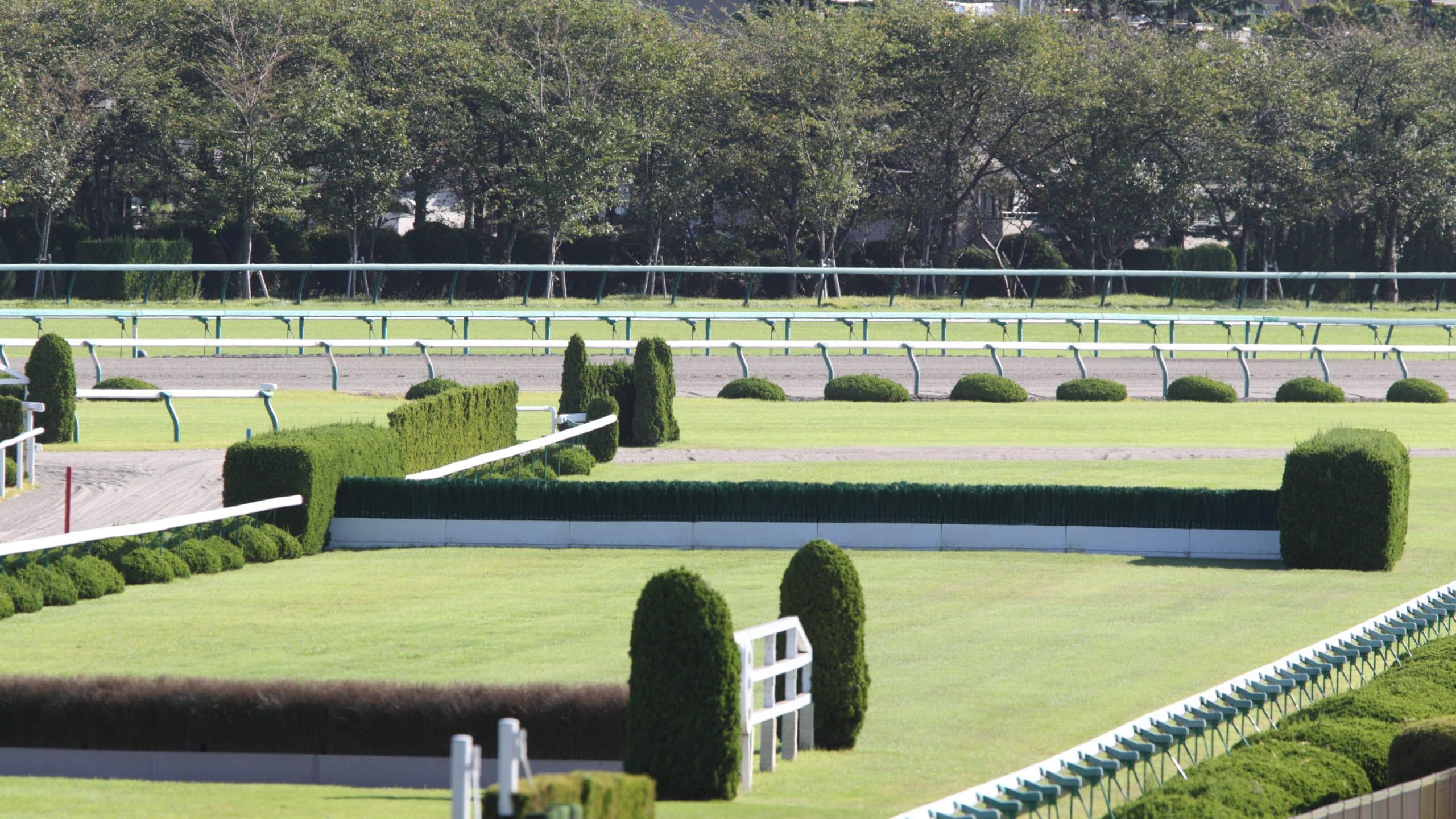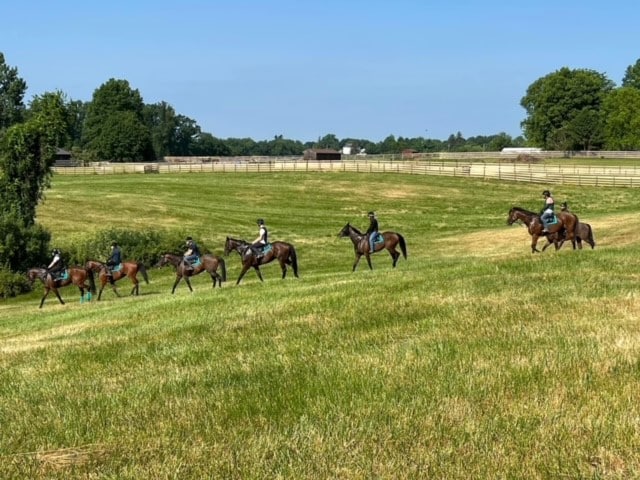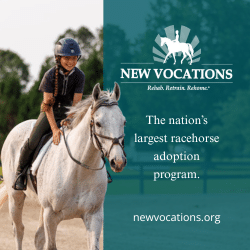
While the number of hurdles in a race depends on the distance and configuration of the track, horses running on an oval course typically jump two hurdles in each straightaway. Getty Images
When attending the cross-country portion of eventing, you first have to figure out where to watch to see the best part of the action. “Cross-country” literally means you can’t see it all.
Steeplechase racing also takes place across long distances and over natural jumps. However, because many races happen at racetracks, you can sit in the grandstand and watch the entire event. Seeing Thoroughbreds sail over hurdles and race to the wire can be exhilarating, and the horses that do it have much the same skill set as eventers.
In fact, many steeplechase horses can go on to become terrific eventers, often because of the training they receive in their first career.
Keri Brion is a leading steeplechase trainer whose charges include 2021 national champion steeplechaser The Mean Queen (Doyen [IRE] — Gail Borden [IRE], Kris Kin). Brion worked for the late Jonathan Sheppard, widely considered one of the all-time great steeplechase trainers and a member of racing’s Hall of Fame.
Brion bases her stable at Fair Hill Training Center, in Maryland, though she and her horses regularly travel to racetracks and other steeplechase venues throughout the eastern United States. Her level of horse care makes her retirees popular when it comes time for their second careers. People contact Brion regularly, asking that she let them know when she has a horse ready to do something else.
Brion says for the most part steeplechase horses — also referred to as jumpers — and their flat-racing counterparts have similar training routines. However, a few differences might make an ex-steeplechaser a good option for those looking for their next event horse.
“The horses are trained a lot like flat horses because they have to have speed,” Brion says. “Day to day it’s not much different. My jumpers train with my flat horses. We’ll gallop on the track. Normally, my jumpers have one day a week where we do a longer gallop, maybe a 2-mile gallop.”
All racehorses need stamina, which is why their training regimen usually consists of daily gallops interspersed with a shorter speed work, called a breeze, perhaps once a week. Steeplechase races tend to be longer than most flat races, and the horses must negotiate hurdles as well. So the horses must be incredibly fit.
“On breeze days I breeze my jumpers very similarly to my flat horses,” Brion says. “Where my flat horses might go five-eighths (of a mile) in 1:01, the jumpers will do it in like 1:04 because they just go a little bit steadier.”
Some steeplechasers begin racing over jumps, while others start out as flat racers and develop into steeplechasers. The Mean Queen first raced in her native Ireland and has always been a steeplechaser. Jimmy P (Slumber [GB] — My Love Venezuela, Scat Daddy), another Brion trainee, initially raced on the flat, running in California, Florida, Maryland, New Jersey and New York before Brion took over his training and developed him into a steeplechaser.
While some horses are bred for steeplechase racing, usually in England or Europe, those in the U.S. are more likely to have been bred for flat racing on the grass, where steeplechase races take place.
“In America there are some sires that you look out for,” Brion says. “But more than anything you’re looking for horses that run long (distances) and just maybe aren’t quite getting there. I love an athletic-looking horse. I don’t like them too big. The physical is important and how they run. I don’t really care if they run on the dirt or the turf.”
Jimmy P in nine starts on the flat won once at 1 ⅛ miles on the grass. In his very first race over hurdles, he finished second at 2 ¼ miles. Through late October 2023 in nine steeplechase races, Jimmy P had won three races and finished second in the Jonathan Sheppard Handicap at Saratoga, in New York.

Fair Hill has miles of horse paths which lends itself well to conditioning steeplechase horses. Photo courtesy Keri Brion
Brion has an advantage training at Fair Hill because the facility offers much more than the average racetrack. In addition to dirt, turf and synthetic training tracks, it has miles of horse paths over different terrain and plenty of turnout paddocks.
“All of my horses get turned out before they get ridden — flat and jumpers — for 30 to 45 minutes,” Brion says. “Some of them go in grass paddocks; some of them go in round pens. I think that is so important for their minds.”
About once a week the steeplechasers school over hurdles.
“When they’re green and learning to jump, we might do two to three days a week,” Brion says. “We try to jump the seasoned horses once a week, depending on the ground. We like it to be good ground. So if it gets too firm or too hard, I might not jump them.”
Fair Hill has a field with hurdles of about 3’6” that includes six to eight inches of brush at the top of the fence. Brion says she often schools the horses over two hurdles in a line three or four times, sometimes individually, sometimes head and head with another horse and sometimes one horse behind the other. That gives horses experience in situations they might encounter during a race.
“Every horse is different,” Brion says. “If I’m getting them ready to run and they’ve never run over jumps before, we do a lot of head-and-head schooling because you want to make sure when they get upside another horse that they’re good about it.”
Any athletic horse can get sour and want a break from his job. Steeplechasers have a couple of built-in advantages that can keep this from happening. The steeplechase season isn’t year-round, usually running from March through November, which gives them a natural break.
“They end up getting the month of December off,” Brion says. “I turn mine out at a couple of farms away from Fair Hill. Fair Hill is beautiful, but it’s still their workplace. I think it’s nice for them to have four weeks where they literally just get to be a horse and relax.”
When the horses return, Brion starts them with plenty of jogging before they go back to their routine of galloping, breezing and schooling over hurdles.
Jump days also help break up any monotony for the horses.
“They enjoy it — those days are kind of like a treat for the horses,” Brion says. “I actually find that jumping sweetens them up. I’ve gotten so many horses that were kind of sour on the flat track. We teach them how to jump, and they think, ‘Oh this is fun,’ and it’s a whole new lease on life.”
Instead of poles on the ground, Brion might introduce steeplechase prospects to jumping by having them hop over logs. She often schools her flat horses over logs as well.
“I think it’s good for their coordination,” she says. “It’s just good for their minds as far as thinking about where their legs are and stuff like that. Normally, all of mine have jumped something.”
Once it’s time to race, a steeplechaser’s routine is again very similar to that of a flat racer, with a couple of exceptions. They are not accompanied to the start by a pony, unlike flat racers in the U.S., and they don’t start from a starting gate. Instead, they line up for a flag start. That might make for a more ragged beginning than in a flat race but, because the distances are so much longer, the start isn’t nearly as crucial.
The number of hurdles in a race depends on the distance and configuration of the track. At Saratoga, for example, steeplechasers race over a normal oval grass course with two turns and two straightaways. Typically, the horses jump two hurdles in each straightaway. In the Jonathan Sheppard Handicap, for instance, horses jump nine hurdles during the 2 ⅜-mile race. In the 2 ⅝-mile Grand National on the bigger Far Hills course, in New Jersey, horses jump 14 fences.
Once steeplechasers finish racing, they have similar career opportunities to flat racers. Some head for the breeding shed, but others go on to various athletic endeavors. And a steeplechaser comes with the extra skill set of already knowing how to jump.
Brion’s trainees also have the advantage of their conditioning at Fair Hill.
“These horses have seen so much,” Brion says. “They’re traffic safe. They jump everything. They cross streams to go gallop. The cross-training definitely sets them up for their next career. It’s great to see.”
Tracy Gantz, a California-based freelance writer, is the Southern California correspondent for BloodHorse, West Coast contributing editor to California Thoroughbred and contributor to The Horse and Speedhorse.

